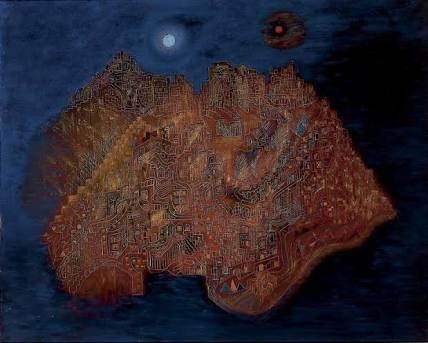Colonial pictures, recovered after a cops-and-robbers chase, go on a show with the Mexican School’s younger generation. The summer season in Mexico offers several interesting prospects, among which one fairly sensational item is an exhibition of smuggled Colonial paintings recently recovered by the government. The story behind these is rich political cream for Fernando Gamboa, head of the plastic arts department of the National Institute of Fine Arts, and a feather in the good-neighbor cap of the head of the San Francisco police. It seems that somebody in San Francisco heard of a cache of antique Mexicana being offered for sale in rather mysterious roundabout ways, looked, and passed the word to the Mexican Consulate. With the California police behind him, began to discover there was more than one such cache. The trail, followed in the very best Perry Mason manner, led to the house of an eccentric millionaire in Los Angeles who had recently died leaving a large collection of art, mostly Colonial Mexican, which his heirs were now in the process of selling off fast.

A Mexican painting from the late 1950
Most of it, when tracked down, turned out to be stuff that could not have crossed the border in orthodox ways, and obviously hadn’t. A lot of the pictures were badly creased, having been folded into small packages. Some had evidently been used for luggage-canvas, and some were so badly smeared and scratched they looked as if they had come in slipped under car-rugs. The Mexican government slapped a claim on all the paintings that could be found, totaling eight hundred, which may or may not be all there were in the original collection. Some of the owners, caught quite innocently with hot art on their hands, very willingly settled with Gamboa for token payments. One or two dealers, who had bought in quantity cheaply, resisted giving up their daydreams of fat returns, but were persuaded to take payment also, through the good offices of the police.

One of the interesting Mexican paintings from 1950
At present, the Bellas Artes experts are busily cleaning and trying to restore as many of the pictures can be saved. Some are beyond repair, but most of them, it seems, can be reclaimed. Up to now, about a hundred and fifty are ready for show. No great names have so far been discovered among them. In fact, the majority of the pictures seem to be unsigned. They are sixteenth- to the eighteenth-century convent and church paintings, informal art, nor yet exactly popular, but somewhere in between and closer to folk-art than to any academy. Such so far clearly visible are unmistakably Mexican in flavor and style, a bit on the naïve and primitive side in many cases, very much like the portraits and genre scenes done by provincial painters in the Flemish tradition, long since Mexicanized with such characteristic touches with garlands, doves, sentimental inscriptions and a certain childlike delicate stiffness of treatment.
Apparently, most of the paintings are from the Querétaro area, and generally central-Mexico, which has produced some of the choicest work of this type. It is supposed that they are officially discards from churches being renovated and refurbished. It happens fairly often that old paintings or sculptures are discarded in favor of something more gilded and pink and blue, and the castoffs find their way to dealers in Mexico, who in turn have their contacts over the border. Of course, there is also a considerable quantity of old painting still kicking around in back rooms of junk dealers, who bought them off guerrilla raiders in the turmoil of revolutionary days. No antique of any sort, however, is supposed to leave the country without an official permit, and therefore practically everything that goes, including things that would probably be given permits travel by unholy route.
Orozco Romero

A painting of Carlos Orozco Romero
Current at Bellas Artes, through June, is a one-man show by Carlos Orozco Romero. Though very well known in Mexico and rapidly reaching top-rank reputation, he has not exhibited much in the U.S. where he is generally known for coldly poetic landscapes. He is one of the few Mexican artists, however, who likes to play, and when he does let himself go, his fantasies can be exceptionally light and tender in mood in a number of Realistic mode.

An authentic painting if the artist.
Among the most interest of his pictures are semi-abstractions, nearly always composed with figures in threes. Whether deliberately experimental or an insistent personal theme, the trio is typically Orozco Romero, as is also an immense interest in arabesque and dance.
Rahon and Martinez

A wonderful exhibit by Alice Rahon
At the Galeria de Arte Mexicano there will be two summer exhibitions of interest. One is the work of Alice Rahon, formerly Alice Paalen. Mme. Rahon is a European refugee who has lived for a good many years in Mexico. She is a non-objective painter, at her best in decorative fantasy, who composes with great precision and delicacy. Color is her forte which is low-voiced, unobtrusive and often exquisite.

Artwork by Ricardo Martinez
The other star at this gallery will be Ricardo Martinez, one of the younger group. Up to recently he has painted monument-size figures and groups, with a strong tendency to blues vaguely reminiscent of Picasso’s Blue Period. His most recent work seems less ambitious and more successful. He has turned to landscape and has found an original idiom there which can best be described as lyric and decidedly not dramatic nor lush. It has happened in several cases of such painters, that they have gone gaudy and soft, and increasingly pretentious. Fortunately Martinez has taken the opposite road, showing hard work, humility and solid progress.
Votive Painting of mexico

A Ex-Voto painting of Mexico
Votive paintings in Mexico go by several names in Spanish such as “ex voto,” “retablo” or “lamina,” which refer to their purpose, place often found, or material from which they are traditionally made respectively. The painting of religious images to give thanks for a miracle or favour received in this country is part of a long tradition of such in the world. The offering of such items has more immediate precedence in both the Mesoamerican and European lines of Mexican culture, but the form that most votive paintings take from the colonial period to the present was brought to Mexico by the Spanish. Another rather unusual exhibition will be put on through the summer months at the Galeria Reger Which is a definitely non-business gallery run by the painter Judson Briggs and his wife Muriel Reger. This show will consist of ex-votos from the best Mexican collections ‘Covarrubias’, Montenegro’s, etc. And in conjunction with it, a series of pictures by the perhaps non-existent Horacio, who may be several people, according to some of the theories passed around. Horacio is the signature on pictures done in the popular nineteenth-century style mostly naive portraits and indoor family scenes, at times indistinguishable from genuinely old pictures, and frequently partly old and partly repainted, as is evident from the age and type of canvas used.
Mexico is full of unknown artists, some old as the hills no doubt, and some quite young, who are painting and carving in styles long since passed, officially, but quite alive in the provinces.



What do you think?